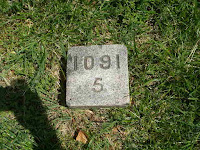Next we moved on to the Battle of Fredericksburg which was conducted in Dec 1863. The thing that struck us was the massive loss of life due to the frontal assaults conducted against entrenched troops, and at this battle, Confederate artillery on the high ground behind the entrenched Confederate troops.
 |
| The "Sunken Road" where Confederate troops were entrenched against repeated frontal assaults. Over 8,000 Fed troops were killed or injured in one afternoon and still failed to reach the Sunken Road |
On the high ground behind the Sunken Road where Confederate artillery was positioned there is now a Federal cemetery that was established immediately after the war. Over, 15,000 dead Federal soldiers are there and the names of over 12,000 are known only to God!
 | ||||||||
| The cemetery on the high ground behind and above the Sunken Rd. | Note the missing headstones. |
We next moved on to the visitor center for the Battle of Chancellorsville, 27 Apr to 6 May 1863. Most battles were named after a community; however in this case it was a single building that was a wayhouse at the intersection of two roads outside of Fredericksburg. Again Lee outmaneuvered the Feds and won the battle.
Our next stop was at Spotsylvania, 8-21 May 1864. A notable part of this battlefield was the Bloody Angle, a slight angle in a trench line that the Feds charged trying to break the line. Hand-to-hand combat raged for 20+ hours in rain and darkness and cold and the bodies just piled up. It gave Lee time to reinforce the line behind the Bloody Angle and when that was done his troops withdrew to that line and held it against the Feds until they withdrew from the battlefield.
An interesting part of the day was finding our way back to Ft AP Hill. These were all back roads and ill marked, especially without a map. We took what my kids would have called "the scenic route". However, on the bright side, BJ used it as a chance to develop her skill with the mapping program on her new iPhone! It did help us get back to AP Hill.
The next day was little less sunny, but we headed to Richmond to see the Richmond National Battlefield Park. It was in downtown Richmond on the river and was at the site of a former foundry that produced some weapons during the Civil War. Unlike Fredericksburg, most of the battles were in surrounding areas and seemed less significant. We also visited the VA State Capital on its beautiful grounds in downtown Richmond! This building was designed by Thomas Jefferson in the old Greek style that was typical of public buildings at the time. He felt it was important that our nation show its culture and strength in public architecture. He fought hard with the politicians of the time to make sure they did not upset/change his designs.
He won most, but not all the battles, and in later years after he was gone, subsequent politicians maintained his style and intent in a fairly consistent manner! Later they added two "wings" because they needed more room and that was the best way to add room and preserve the integrity of Jefferson's design.
We enjoyed our visit to Richmond and the ride back was a lot less "challenging" then the previous day. We got on I-95N and headed back to our exit for Ft AP Hill.


No comments:
Post a Comment